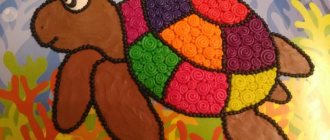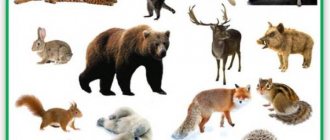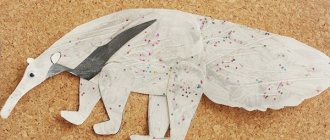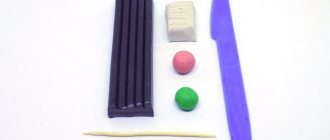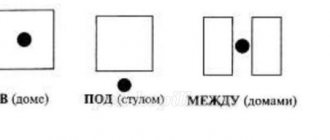Program content: to form in children a generalized idea that a cow and a goat are domestic animals (they live in a person’s barn, barn), are not afraid of him and allow him to take care of them; bring benefits - the cow gives milk, meat, horns, skin; goat - milk, skin, wool, fluff; a person takes care of them, creates all the conditions for life: builds a special room, cleans it, feeds, waters, prepares hay).
Material: series of paintings about a cow (No. 8, 9) and a goat (No. 17) from the educational visual aid “Pictures from the life of domestic animals”, flannelgraph, pictures for it.
Progress of the lesson
Part 1. The teacher takes turns looking at the paintings “Cow in the Barn in Winter” (No. 9) and “Goat in the Barn in Winter” (No. 17) with the children, and asks approximately the following questions: who is depicted in the picture? What does a cow (goat) do? Where is it? What does a woman do? Why did she come to the barn? What is the girl doing? Why did the owners get a cow (goat)? What do they get from it? How do the owners take care of her? What can you learn about this from the picture?
To summarize, the teacher says: “This is how the housewife takes care of the cow (goat) in cold weather - in autumn, winter. But in the summer everything was different. Look at another painting (exhibits painting No. 8). Here is a picture of a small herd of cows grazing in a meadow near a pond. A shepherd sits in the shade under a tree, the housewives come to milk their cows at noon. The weather is hot, the cows graze in different ways: some nibble grass (shows), others drink water from the pond (shows), and this cow is resting, chewing the cud.”
All paintings are removed.
Part 2. The teacher forms generalized ideas about animals in children using a flannelgraph and small pictures. At the same time, he contrasts domestic animals with wild ones, relying on characteristics characteristic of each group: “Children, you probably know that there are domestic animals, and there are wild ones. Now we will find out which animals the cow and goat are domestic or wild.
All domestic animals live with humans and are not afraid of him, but wild animals try to live away from humans, they are very timid, they are afraid of everyone. I will depict it on a flannelgraph in this way (puts pictures: roof of a house, people). Now you put pictures with a cow and a goat. (Children put up pictures, the teacher makes sure that people and animals are together under the roof.)
All pets are beneficial to humans. Find pictures that show the benefits of a cow and a goat, and place them on the flannelgraph on the left. (Children put up pictures, name what is depicted, the teacher helps.) And now I will put an arrow from all these objects to the person. You see the great benefits of keeping these farm animals.
But pet owners not only use them, but also constantly take care of them, creating all the conditions for them to feel good and not get sick. Now on the other side - on the right - put pictures that show how people take care of a cow and a goat. (Children put pictures, the teacher helps, clarifies.) And I will put an arrow so that it connects the pictures with a person and objects and indicates his affairs and care for his pets.
But wild animals live separately from humans, fear him and take care of themselves. Tell me now: are cows and goats domestic animals or wild ones? Why do you think they are homemade? (That's right, they live with people in the village. The owners build a barn for them so that they are warm, so that they are not attacked by predators. People feed and water the cow and goat, store feed and hay, take care of the animals. And the cow and goat bring a lot of benefits - they provide meat, milk, goat fluff, skin and more.")
The teacher leaves the pictures and flannelgraph in the group for a while.
Open lesson in kindergarten on the topic “Pets” (senior group)
art therapy specialist
LESSON TOPIC: Pets
Goal:
Consolidating the knowledge of older preschool children about wild and domestic animals.
Educational:
Continue to clarify and systematize children’s ideas about wild and domestic animals, about their lives, that domestic animals were not always domestic, but that humans helped the animal become domestic, give ideas about the dog as the first domestic animal.
Educational:
Arouse interest in the life of animals, develop skills in environmentally friendly behavior; Expand words knowledge; develop children's imagination, curiosity, memory and thinking.
Educational:
Foster respect for animals; sense of camaraderie.
Materials for the lesson:
pictures depicting domestic animals (goat, sheep, horse, cow, pig, cat, dog) and pictures depicting wild animals (wolf, fox, hare, deer, wild boar, bear); doll Masha; toy – dog, stand with names and photographs of children’s pets.
Vocabulary work:
pets, wild animals, benefit, dog, breed.
Preliminary work:
Looking at paintings and illustrations with domestic animals, talking about wild and domestic animals; conversation about the benefits of pets; didactic games for the classification of wild and domestic animals.
